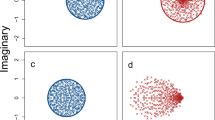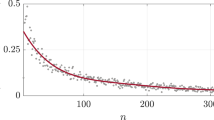Abstract
Many complex systems display a surprising degree of tolerance against errors. For example, relatively simple organisms grow, persist and reproduce despite drastic pharmaceutical or environmental interventions, an error tolerance attributed to the robustness of the underlying metabolic network1. Complex communication networks2 display a surprising degree of robustness: although key components regularly malfunction, local failures rarely lead to the loss of the global information-carrying ability of the network. The stability of these and other complex systems is often attributed to the redundant wiring of the functional web defined by the systems' components. Here we demonstrate that error tolerance is not shared by all redundant systems: it is displayed only by a class of inhomogeneously wired networks, called scale-free networks, which include the World-Wide Web3,4,5, the Internet6, social networks7 and cells8. We find that such networks display an unexpected degree of robustness, the ability of their nodes to communicate being unaffected even by unrealistically high failure rates. However, error tolerance comes at a high price in that these networks are extremely vulnerable to attacks (that is, to the selection and removal of a few nodes that play a vital role in maintaining the network's connectivity). Such error tolerance and attack vulnerability are generic properties of communication networks.
This is a preview of subscription content, access via your institution
Access options
Subscribe to this journal
Receive 51 print issues and online access
$199.00 per year
only $3.90 per issue
Buy this article
- Purchase on Springer Link
- Instant access to full article PDF
Prices may be subject to local taxes which are calculated during checkout




Similar content being viewed by others
References
Hartwell, L. H., Hopfield, J. J., Leibler, S. & Murray, A. W. From molecular to modular cell biology. Nature 402, 47–52 (1999).
Claffy, K., Monk, T. E. et al. Internet tomography. Nature Web Matters [online] (7 Jan. 99) 〈http://helix.nature.com/webmatters/tomog/tomog.html〉 (1999).
Albert, R., Jeong, H. & Barabási, A.-L. Diameter of the World-Wide Web. Nature 401, 130–131 ( 1999).
Kumar, R., Raghavan, P., Rajalopagan, S. & Tomkins, A. in Proc. 9th ACM Symp. on Principles of Database Systems 1–10 (Association for Computing Machinery, New York, 2000).
Huberman, B. A. & Adamic, L. A. Growth dynamics of the World-Wide Web. Nature 401, 131 (1999).
Faloutsos, M., Faloutsos, P. & Faloutsos, C. On power-law relationships of the internet topology, ACM SIGCOMM '99. Comput. Commun. Rev. 29, 251–263 (1999).
Wasserman, S. & Faust, K. Social Network Analysis (Cambridge Univ. Press, Cambridge, 1994).
Jeong, H., Tombor, B., Albert, R., Oltvai, Z. & Barabási, A.-L. The large-scale organization of metabolic networks. Nature (in the press).
Erdös, P. & Rényi, A. On the evolution of random graphs. Publ. Math. Inst. Hung. Acad. Sci. 5, 17–60 (1960).
Bollobás, B. Random Graphs (Academic, London, 1985).
Watts, D. J. & Strogatz, S. H. Collective dynamics of ‘small-world’ networks. Nature 393, 440– 442 (1998).
Zegura, E. W., Calvert, K. L. & Donahoo, M. J. A quantitative comparison of graph-based models for internet topology. IEEE/ACM Trans. Network. 5, 770–787 (1997).
Williams, R. J. & Martinez, N. D. Simple rules yield complex food webs. Nature 404, 180 –183 (2000).
Maritan, A., Colaiori, F., Flammini, A., Cieplak, M. & Banavar, J. Universality classes of optimal channel networks. Science 272, 984– 986 (1996).
Banavar, J. R., Maritan, A. & Rinaldo, A. Size and form in efficient transportation networks. Nature 399, 130–132 (1999).
Barthélémy, M. & Amaral, L. A. N. Small-world networks: evidence for a crossover picture. Phys. Rev. Lett. 82, 3180–3183 ( 1999).
Barabási, A.-L. & Albert, R. Emergence of scaling in random networks. Science 286, 509– 511 (1999).
Barabási, A.-L., Albert, R. & Jeong, H. Mean-field theory for scale-free random networks. Physica A 272, 173–187 ( 1999).
Redner, S. How popular is your paper? An empirical study of the citation distribution. Euro. Phys. J. B 4, 131– 134 (1998).
Lawrence, S. & Giles, C. L. Accessibility of information on the web. Nature 400, 107– 109 (1999).
Milgram, S. The small-world problem. Psychol. Today 2, 60–67 (1967).
Bunde, A. & Havlin, S. (eds) Fractals and Disordered Systems (Springer, New York, 1996).
Paxson, V. End-to-end routing behavior in the internet. IEEE/ACM Trans. Network. 5, 601–618 ( 1997).
Adamic, L. A. The small world web. Lect. Notes Comput. Sci. 1696, 443–452 (1999).
Acknowledgements
We thank B. Bunker, K. Newman, Z. N. Oltvai and P. Schiffer for discussions. This work was supported by the NSF.
Author information
Authors and Affiliations
Corresponding author
Rights and permissions
About this article
Cite this article
Albert, R., Jeong, H. & Barabási, AL. Error and attack tolerance of complex networks. Nature 406, 378–382 (2000). https://doi.org/10.1038/35019019
Received:
Accepted:
Issue Date:
DOI: https://doi.org/10.1038/35019019
This article is cited by
-
Adaptive link dynamics drive online hate networks and their mainstream influence
npj Complexity (2024)
-
The Spatiotemporal Evolution Mechanism of Urban Rail Transit Fault Propagation in Networked Operation Modes
Urban Rail Transit (2024)
-
Resource predictability modulates spatial-use networks in an endangered scavenger species
Movement Ecology (2023)
-
Oxidation-induced superelasticity in metallic glass nanotubes
Nature Materials (2023)
-
Local flux coordination and global gene expression regulation in metabolic modeling
Nature Communications (2023)
Comments
By submitting a comment you agree to abide by our Terms and Community Guidelines. If you find something abusive or that does not comply with our terms or guidelines please flag it as inappropriate.



